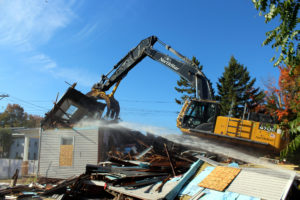
By Michael P. Walsh
Special to the Voice
The long-anticipated demolition phase for The Haven kicked off Oct. 19 with the razing of a house at Main Street and First Avenue, Mayor Edward M. O’Brien announced.
The house, 53 Main St., was the first of four houses taken down for the initial phase by The Haven Group LLC to clear the way for “America’s first upscale waterfront outlet mall,” said Matt Armstrong, executive vice president of The Haven Group.
Armstrong said the work is being done by LVI Environmental Services Inc./Northstar Contracting Group Inc. of Milford, a subcontractor of Standard Builders of Newington.
The demolition was preceded by an environmental remediation of the house by LVI, which included asbestos removal, he said.
City Planning and Development Commissioner Joseph A. Riccio, Jr. said The Haven Group recently obtained the demolition permit for 53 Main St., valued around $1,000, from the Building Department and is in the process of securing three additional permits to start razing the more than 50 properties acquired by the Dallas-based development company for the $200 million project.
The other addresses are 315-317 First Ave., 321 First Ave. and 325 First Ave.
LVI foreman Rich Meehan said the house at 315-317 First Ave. was abated and was slated for demolition this week, followed by the other two First Avenue houses.
Meehan said phase two of the demolition is expected to target the buildings on Water Street, including the former Bilco Co.
“We are all very excited that The Haven is moving forward as scheduled and is humming with activity,” O’Brien said. “The people of West Haven will now see a tangible path of progress aimed at building a brighter future for this proud neighborhood and our great city.”
Armstrong said, “This is an important milestone in the development of The Haven, and I am excited to see our vision begin to take shape.”
Developer Ty Miller is preparing to build dozens of luxury retail shops, a 200-seat amphitheater, seven restaurants and a waterfront promenade in the 24-acre Water Street project area, which comprises 55 properties bounded by Main Street, First Avenue and Elm Street.
The development, known as The Haven South, includes no housing, said Armstrong, adding that the City Council-adopted Haven South Municipal Development Plan, or MDP, prohibits housing.
Armstrong said negotiations have concluded between The Haven Group and the owners of the two remaining properties. The developer and the property owners are preparing closing documents and are scheduling closings in the near future, he said.
Armstrong said the developer has spent more than $30 million so far on the privately financed development, which he has compared to the top 20 percent of the retail stores that constitute Woodbury Common Premium Outlets in Central Valley, New York, about 50 miles north of New York City.
“We are committed to the city of West Haven,” Armstrong told a group of 25 city leaders, including police and fire officials, during O’Brien’s department head meeting April 7 at City Hall. “We don’t want to walk away from a ($30 million) investment.”
Armstrong has cited the site’s proximity to interstates 95 and 91 and the Merritt and Wilbur Cross parkways and the West Haven train station, along with its visibility from I-95, as the driving factors why the developers selected West Haven for the project.
The 250,000-square-foot development is expected to feature 60 upscale fashion outlet stores.
Armstrong said the project is poised to create up to 800 full- and part-time jobs, as well as hundreds of construction jobs, and to generate $2 million in annual property tax revenue for the city.
“This will be a luxury waterfront shopping destination, which makes it unique,” he said at the April meeting.
The Haven is expected to make West Haven a major destination in the Northeast, much like in its heyday of Savin Rock Park. The former amusement hub was the city’s main shoreline attraction and economic resource for decades until its demise in 1966.
The Haven is also the largest-scale development in West Haven since the construction of Dome Laboratories, which later became Miles Laboratories, on the old Rully pig farm in the 1960s. The Morgan Lane site was expanded into Orange in the 1990s by Bayer Corp., becoming the 136.4-acre Bayer HealthCare complex, and became the Yale University West Campus in 2007.